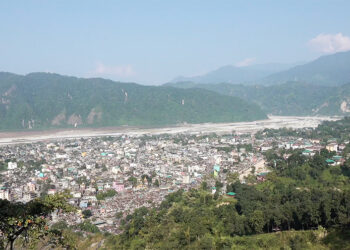
Every summer, the five households of Tshokona Chiwog under Barp Gewog in Punakha have to endure a dreadful ordeal. Being located near the Punatshangchhu river, where the Natural Resources Development Corporation Limited’s (NRDCL) sand dredging works take place, they face land erosion and degradation during the wet season.
So, to put a definite end to the problem, the NRDCL has begun piloting the construction of a river protection embankment along the riverside since last year.
 This recent footage shows sand and gravel being mounted on the river bank. There is no scene of river flooding. But, come summer, this whole area would be underwater due to heavy rainfall.
This recent footage shows sand and gravel being mounted on the river bank. There is no scene of river flooding. But, come summer, this whole area would be underwater due to heavy rainfall.
The five households of Tshokona Village allege the sand extraction works pose serious threats to their agricultural fields. During the summer, the rain-swollen river overflows their farms and causes soil erosion, preventing sustainable farming.
After repeated complaints, the NRDCL constructed a wire mesh retaining wall alongside the river eight years ago.
But the wall failed to contain the swelling river. So, the NRDCL constructed more than 270 metres long and five metres tall embankments on a trial basis.
This river protection approach involves mounting earth-fill structures such as sand and gravel.
“Initially, we constructed around 150 metres of river embankment last year to see how far it prevents land erosion. We found out this approach was effective since it has not weakened the soil. This encouraged us to continue,” tells Mani Gyeltshen, the Manager of NRDCL Branch Office in Wangdue.
The aim is to build more than 700 metres long embankment if it proves effective. But as obvious as it may sound, the COVID-19 pandemic pushed the plan to be implemented at later dates.
“We will construct 200 meters more every year provided it is effective. We plan to stop and control the soil erosion completely in the area in future. However, we might have to discuss with our head office and come up with a new preventive method if this one fails,” he continues.
 Some villagers have spoken in favour of this river containment approach.
Some villagers have spoken in favour of this river containment approach.
“We would feel protected if they could construct this embankment for the whole area. Well, we can’t do anything if the water level rises and overflows in summer. But this method seems to protect the soil from erosion as grabbles are holding back the soils while declining the water level,” says one of the villagers of Tshokona Chiwog, Nado.
However, some others are skeptical about the embankment’s sustainability and resilience to soil erosion.
“During the summer, the force of the river pierces the edge of our land, leading to erosion and the matter gets worse every year. So, we cannot say how the embankment will prevent the river from overflowing. We requested the NRDCL to construct the river mitigation walls like the one constructed on the other side, which is Bajo,” shares another villager, Tshewang Nidup.
The sand dredging activities along the Punatshangchhu River gain momentum from November until March every year.
Gewog officials say if the river protection embankment proves successful, the affected households can rethink doing large scale farming.
Changa Dorji, Wangdue Phodrang
Edited by Pema Lhaden






